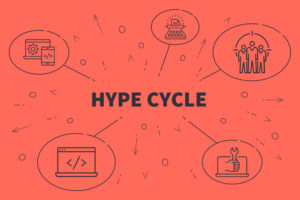
Gartner Sees AI Democratized in Latest ‘Hype Cycle’

(OpturaDesign/Shutterstock)
Democratized artificial intelligence is one of five trends driving Gartner’s latest Hype Cycle for Emerging Technologies, which it updates this month, as it traditionally does during the month of August.
The analyst group took a slightly different approach with this year’s Hype Cycle for Emerging Tech and grouped the 35 individual technologies into major groups, which includes digitalized ecosystems, do-it-yourself biohacking, transparently immersive experiences, and ubiquitous infrastructure, along with democratized AI.
The five trends will “blur the lines between human and machine,” Gartner says. “CIOs and technology leaders should always be scanning the market along with assessing and piloting emerging technologies to identify new business opportunities with high impact potential and strategic relevance for their business,” writes Mike J. Walker, research vice president at Gartner.
The AI group contains technologies like AI platform as a service (PaaS), artificial general intelligence, autonomous driving (levels 4 and 5), autonomous mobile robots, conversational AI platform, deep neural nets, flying autonomous vehicles, smart robots, and virtual assistants.
Deep neural nets and virtualized assistants are on track to reach mainstream adoption in the next two to five years, Walker says, while other tech, like smart robots and AI PaaS, are maturing quickly. Fully self-driving cars and full autofocus mobile robots are at least five to 10 years out, he says.
Walker says AI is on the front-burner and will become more widely available more quickly than technology in other categories due to three main factors: cloud computing, open source, and the “maker” community, Gartner says.
While early adopters of AI tech are benefiting from the rapid evolution, the bigger impact will be felt by its availability to the masses, not to mention the “maker community” of developers, data scientists and AI architects who continue to create “compelling solutions based on AI.”
“Big data” hasn’t been a thing on the hype curve for years, but there are plenty of big data technologies. In the digitized ecosystem category, Gartner sees blockchain, digital twins, IoT platforms, and knowledge graphs impacting the technological growth curve.
“Digitalized ecosystem technologies are making their way to the Hype Cycle fast,” Walker says. “Blockchain and IoT platforms have crossed the peak by now, and we believe that they will reach maturity in the next five to 10 years, with digital twins and knowledge graphs on their heels.”
While the “do-it-yourself biohacking” category may summon images of Frankenstein’s monster, Gartner sees a more benevolent future where technologies like augmented reality, smart fabrics, biochips, and brain-computer interfaces help bolster the human condition. Most of these technologies aren’t close to maturity, however.
Transparently immersive experiences, meanwhile, will be based on technologies like 4D printing, edge AI, the connected home, the smart workspace, silicon anode batteries, and smart dust, which made a small but noticeable climb up toward the peak of inflated expectations (but is still at least five to 10 years away) compared to last year.
Thanks to the cloud and mobile devices, we no longer think of computers as things that sit only on desks, laps or in giant racks. Indeed, according to Gartner, we can now think of computer infrasstrucdture as something that’s ubiquitious.
To that end, Gartner sees technologies like deep neural network ASICs, quantum computing, 5G networks, carbon nanotube, and neuromorphic hardware as helping to drive the next breakthrough in the space, with 5G and deep neural network delivering benefits within two to five years.
Related Items:
How AI Fares in Gartner’s Latest Hype Cycle
Smart Machines’ Top the Hype Cycle, Gartner Says
Why Gartner Dropped Big Data Off the Hype Curve
Most Hyped Tech: Big Data Out, IoT In
































